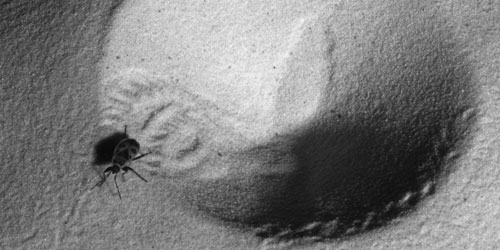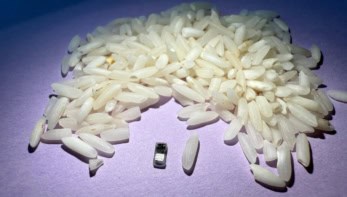
For an ant that’s fallen into a pit dug in the sand by the larvae of “antlion” insects, the ability to climb up a granular slope is a matter of life or death. Now, a group of scientists in France has discovered why certain medium-sized ants are unlikely to make it out alive of these conical, centimetre-sized traps – no matter how hard they try. The physics of friction, the researchers found, dictates that these ants are heavy enough to deform a pit’s sandy slope but not so heavy that they create stabilising footprints. Instead, the unlucky creatures slide to the bottom of the pit and are eaten alive.
It was a 17th-century French scientist – physicist Guillaume Amontons – who formulated three laws of friction still in use today. The first states that the frictional force experienced by an object resting on a surface is proportional to that object’s gravitational force – and hence its mass. But in the latest research, Jérôme Crassous of the University of Rennes and colleagues have shown that friction’s dependence on mass is much more complicated for tiny objects on granular surfaces, and it is this complexity that determines the fate of ants in antlion pits.
Box of beads
Crassous and co-workers filled a box with glass beads of varying sizes, tipping the box each time so that the beads formed a slope with a range of angles approaching that at which avalanches most readily cascade down a mountainside – the angle that antlions also use in their pits. The researchers then rested small discs of metal covered in cardboard on the granular slope and recorded how easily the discs slid down it, repeating the exercise many times over. This they did for discs of various masses and with differing surface areas in contact with the slope.
The researchers found, as expected, that the probability for a disc to slide to the bottom of the slope increased as the slope’s angle approaches that characteristic of avalanches (the precise value depending on the size of the beads). What was far more remarkable, they report, was how that probability depended on the pressure that a disc exerts on the slope; in other words, on the disc’s mass. Rather than being independent of pressure, they found that for a given angle the chances of sliding were greatest at particular, intermediate pressures.
To understand what was going on, the researchers photographed the tracks that the discs made in the granular material (in their paper, they actually show tracks made in sand). Very small discs did not slide and so left no tracks, whereas intermediate-sized discs created tracks that became more visible as their mass increased. The most massive objects also created tracks, but because they built up ridges of granular material ahead of them they did not slide far.
Model creatures
Crassous and co-workers were able to model this behaviour mathematically. To investigate the onset of sliding at low masses, they assumed that the beads underneath a disc act like damped springs and that once the vertical force acting on them crosses a threshold the granular surface destabilises. At higher masses, instead, they devised an expression for the resistive force imparted on a disc by the accumulated beads, and then used that to work out the pressure at which sliding should cease.
The researchers also carried out a separate experiment in which they used a sensor to measure the frictional force on an object as it moved along a horizontal granular surface. They found, in agreement with their slope experiment, that the lowest coefficient of friction occurred for objects exerting a small, but not very small, pressure. As they point out, previous studies of friction on granular surfaces – which do not report such a dip in the coefficient – were carried out using larger masses.
Ant magic
Applying their work to the natural world, the researchers compared their results to those reported two years ago by a group comprising two of the current team (Antoine Humeau and Jérôme Casas of the CNRS Insect Biology Research Institute in Tours). That earlier research investigated which of various sized ant species – the biggest weighing in at 8 mg – an antlion could most readily capture in traps built from small glass beads. The easiest prey, in fact, were ants weighing about 2 mg. In other words, both studies indicate that it is ants with an intermediate mass that are most vulnerable to antlions.
Daniel Goldman, a biomechanics expert at the Georgia Institute of Technology in the US, praises the “creative” work of the French group, agreeing that it “points to novel granular slope physics which could be relevant to antlion prey capture”. He also believes the research could have practical applications, helping scientists to better tune robots’ motion so that they generate appropriate pressures when ascending sandy slopes on Earth and other planets.
The research is published in Physical Review Letters.



